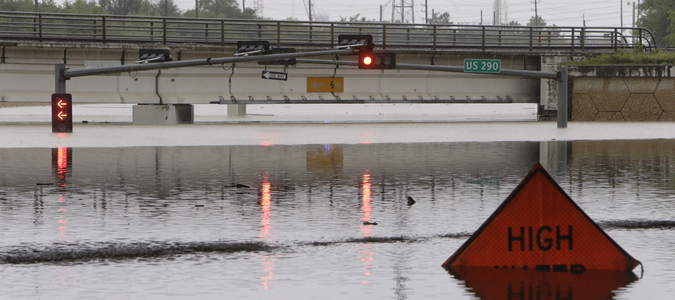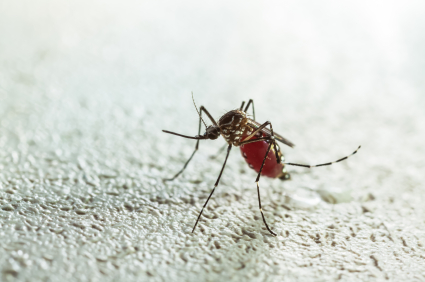
Photo Credit: Houston Chronicle
Harris County and the Houston metro area have seen a major increase in flooding over the past couple of years. This past weekend through Monday saw disastrous torrential rainfall, totaling close to 20 inches in some northern parts of the metro area, near Cypress Creek. During these highly troubling weather events, we urge our customers’ and their families to stay off the roads.
The floodwaters may be subsiding, but another problem comes with high volumes of rain: mosquitoes. This year, health dilemmas like Zika Virus and weather patterns like El Niño and La Niña are compounding the mosquito issues Southeast Texas residents face every year. As summer quickly approaches, one bad flood after another may spur earlier than usual mosquito problems for Houston residents.
Why do mosquitoes like these conditions?

Mosquitoes are like all other insects in that they begin life as a larva. The most common types of mosquitoes either lay their eggs on the surface of very stagnant water or near water sources in damp soil. Once the larvae have hatched, they go on to mature while in the stagnant water. This is why we see more problems with mosquitoes after a flood rather than a regular rain shower — Rain can actually wash away the eggs. But flooding, on the other hand, leaves residual water behind even after it recedes.
When flood waters cover large ground surfaces outside of source creek beds and rivers, those areas become a mosquito breeding ground. As long as the ground or other surfaces are wet, mosquito larvae and pupa can mature. This means that flooding multiplies the area that a mosquito can grow to the adult stage.
El Niño & La Niña Affect Mosquitoes in Texas
You have probably heard of the periodic weather patterns known as El Niño and La Niña. Every few years, as an area of the Pacific Ocean heats up to above average temperatures, El Niño pays North America a visit. It is usually followed by La Niña which is most likely the case this year. La Niña makes for much warmer temperatures in the summer months for Texans.
El Niño years also bring a greater number of pest-related problems to the Houston region, including but not limited to mosquitoes. Some rodents are good swimmers, but heavy flooding will send them scurrying to shelter on higher ground. Carpenter ants and fire ants become a bigger issue for homeowners after heavy rain storms, too.
Mosquitoes and other insect infestations tend to be far worse during the El Niño phase, but La Niña will likely extend summer temperatures well into October and November this coming fall. Higher temperatures for a longer period ultimately means that the mosquitoes will stick around. Luckily, the La Niña phase might lead to fewer heavy rainfall events in the latter part of the year.
More Floods. More Mosquitoes. More Mosquito Diseases.
In early April, the CDC updated the public about Zika’s link to birth defects in babies and Guillian-Barré syndrome in adults. A report was recently published in the New England Journal of Medicine showing a causal link between Zika and these more serious diseases.
The CDC still recommends that people traveling to Central and South America take a higher level of caution. Pregnant women or women who may become pregnant are urged to avoid travel to those destinations listed at this time.
If travel to Central and South America is a necessity, do so wisely. Wear good bug repellent with DEET, long sleeves, socks, and cover your face and neck when outdoors. This may sound a little uncomfortable during the summer months, but it can protect you from mosquito bites in these regions. Luckily, some studies have shown that light or pale colored clothing do better work repelling mosquitoes than dark or black fabrics. Wearing white can also have a cooling effect. If possible, you should also sleep under a mosquito net.
Important Post-Flood Tips
After the water subsides, our city will be left with quite a mess to clean-up. Coming into contact with flood water runoff can be dangerous, so we don’t recommend you do so. But here are some tips if you need to take on the cleaning tasks yourself.
- While cleaning outside, wear protective coveralls or long clothing to cover your skin from contaminated water and dust.
- If you have a lot of trash and plastic to remove, wear a mask and gloves to protect your face from dust particles leftover from floodwaters. Trash should be quickly removed before it starts to degrade.
- Sadly, you will have to throw out any vegetables from your garden that have come into contact with flood water. Wash away excess particles in your yard and soil with a hose. Depending on how much moisture and particles are leftover, you may need to consider resodding your lawn.
- Dump stagnant water out immediately. If the heavy rains have left pools of water sitting on top of your pool cover, in your gutters, or inside plant pots, dump that water out into a nearby sewer drain. These are all potential mosquito breeding grounds.